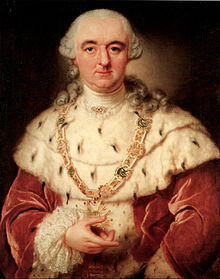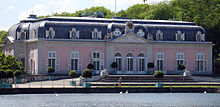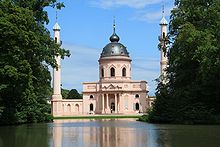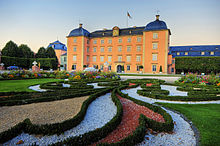- Charles Theodore, Elector of Bavaria
-
Charles Theodore 
Charles Theodore, as painted by Anna Dorothea Therbusch in 1763 Duke of Bavaria
Count Palatine of the Rhine
Prince-elector of the Holy Roman EmpireReign 1742 (Palatinate, aged 17)
1777 (Bavaria, aged 53)
to 1799Predecessor Charles III Philip (Palatinate)
Maximilian III Joseph (Bavaria)Successor Maximilian IV Joseph Spouse Elisabeth Augusta of Sulzbach
Maria Leopoldine of Austria-EsteFather John Christian, Count Palatine of Sulzbach Mother Marie Henriette de la Tour d'Auvergne Born December 11, 1724
Drogenbusch Palace, Brussels, Austrian NetherlandsDied February 16, 1799 (aged 74)
Munich Residenz, BavariaBurial Theatine Church, Munich Charles Theodore, Prince-Elector, Count Palatine and Duke of Bavaria (German: Karl Theodor; December 11, 1724 – February 16, 1799) reigned as Prince-Elector and Count Palatine from 1742, as Duke of Jülich and Berg from 1742 and also as Prince-Elector and Duke of Bavaria from 1777, until his death. He was a member of the House of Palatinate-Sulzbach, a branch of the House of Wittelsbach.
Contents
Biography
Family and ascent to rule
Charles Theodore was of the Wittelsbach house Palatinate-Sulzbach.[1] His parents were Johann Christian, Count Palatine of Sulzbach and Marie-Anne-Henriette-Leopoldine de La Tour d'Auvergne, margravine of Bergen op Zoom, a grandniece of Henri de la Tour d'Auvergne, Vicomte de Turenne. Charles Theodore was born in Drogenbos near Brussels and educated in Mannheim.
Charles Theodore was margrave of Bergen op Zoom from 1728 onwards. He then succeeded his father as Count Palatine of Sulzbach in 1733 and inherited the Electoral Palatinate and the duchies of Jülich and Berg in 1742, with the death of Charles III Philip, Elector Palatine. To strengthen the union of all lines of the Wittelsbach dynasty Charles III Philip had organized a wedding on January 17, 1742 when his granddaughter Elizabeth Augusta was married to Charles Theodore and her sister Maria Anna to the Bavarian prince Clement.
As reigning Prince Elector Palatine, Charles Theodore won the hearts of his subjects by founding an academy of science, stocking up the museums' collections and supporting the arts. When Maximilian III Joseph of Bavaria died in 1777, Charles Theodore became also Elector and Duke of Bavaria and moved to Munich.
Bavarian succession
Charles Theodore did not immediately take up his new title. He had several mistresses and many illegitimate children. However, these bastards could inherit neither the Electorate of Bavaria nor that of the Palatine; Charles Theodore needed territory that he could bequeath to his illegitimate children. Charles Theodore also dreamed of resurrecting the Burgundian Empire of the Middle Ages.[citation needed]
So, on 3 January 1778, shortly after the death of Max Joseph, Charles Theodore signed an agreement with Emperor Joseph II to exchange southern Bavaria for part of the Austrian Netherlands.
This plan was strongly opposed by Maria Anna Sophia of Saxony, the widow of Max Joseph, and Charles Theodore's cousin Charles II August, Duke of Zweibrücken, the head of the House of Palatinate-Birkenfeld and next heir of Bavaria and the Palatinate. They were supported by Frederick II of Prussia, and most of the German minor states.
The ensuing diplomatic crisis led to the War of the Bavarian Succession, which was ended by the Peace of Teschen (1779). Charles Theodore accepted the Bavarian succession, but agreed that his illegitimate descendants could not inherit Bavaria.[2] Austria acquired the Innviertel, a part of Bavaria in the basin of the Inn river.[3]
Charles Theodore had only one son with his wife, Countess Elizabeth Augusta of Sulzbach, who died a day after birth. His wife died in 1784. In 1795, he married Maria Leopoldine of Austria-Este, Joseph's niece, but they had no children. A second proposal to exchange Bavaria for the Austrian Netherlands in 1784 also failed.
When Charles Theodore died, Bavaria and the Electorate passed to his cousin, Max Joseph, Duke of Zweibrücken, the younger brother of Charles August, who had died in 1795.
In 1989, Marvin E. Thomas in Karl Theodor and the Bavarian Succession, 1777–1778 argued that in fact Charles Theodore wanted to maintain possession of his new territory, and that this is shown in his diplomatic correspondence. Thomas is the only scholar to produce such an analysis.[4] It is more widely understood that Charles Theodore continued the despotic and expensive habits he had developed as Elector Palatine.
Rule as Elector of Bavaria
Charles Theodore never became popular as a ruler in Bavaria according to his critic Lorenz von Westenrieder. He attempted without success to exchange the ducal lands of Bavaria for the Austrian Netherlands and a royal crown, and he never managed to control the mounting social tensions in Bavaria. After a dispute with Munich's city council Karl Theodor even moved the Electoral residence in 1788 to Mannheim but returned only one year later.[5]
In 1785, he appointed the American Loyalist exile Benjamin Thompson as his aide-de-camp and chamberlain. Over the next 11 years, Thompson reformed the army and many aspects of the state, rising to high ministerial rank with Charles Theodore's backing, and becoming Count von Rumford.
Charles Theodore is also known for disbanding Adam Weishaupt's order of the Illuminati in 1785.
In 1794, the armies of revolutionary France occupied the Duchy of Jülich, in 1795 they invaded the Palatinate, and in 1796 marched towards Bavaria. Charles Theodore begged Francis II for help which in essence would have made Bavaria a puppet state of Austria. When he died of a stroke in Munich in 1799, the population in Munich celebrated for several days. He is buried in the crypt of the Theatinerkirche in Munich.
Despite the mutual dislike and distrust between the Duke and his Bavarian subjects, Charles Theodore left a distinctive mark on the city of Munich: it was during his reign that the English Garden, Munich's largest park, was created, and the city's old fortifications were dismantled to make place for a modern, expanding city. One of Munich's major squares, Karlsplatz, is named after Charles Theodore. Munich natives, however, seldom use that name, calling the square instead Stachus, after the pub "Beim Stachus" that was located there until construction work for Karlsplatz began. One of the main reasons for this is that Charles Theodore, as noted above, never enjoyed the popularity in Bavaria that he enjoyed in the Palatinate.
Silver thaler coin of Charles Theodore, 1778. 
Obverse
CAR[OLUS] TH[EODORUS] D[EI] G[RATIA] C[OMES] P[ALATINUS] R[HENI] U[TRIUSQUE] B[AVARIAE] D[UX] S[ACRI] R[OMANI] I[MPERII] A[RCHIDAPIFER] & EL[ECTOR] D[UX] I[ULIACI] C[LIVIAE] & M[ONTIUM]."Charles Theodore, by the Grace of God, Count Palatine of the Rhine, Duke of both (Upper and Lower) Bavaria, Archsteward and Elector of the Holy Roman Empire, Duke of Jülich, Cleves and Berg." Right profile of Karl Theodor in armor with sash and decoration.Reverse
PATRONA BAVARIAE 1778. "Patroness of Bavaria 1778." Image of the crowned Virgin with the Christ child, bearing orb and sceptre, seated upon clouds before a sunburst, and treading on a crescent moon.Character
Charles Theodore was more interested in arts and philosophy than in politics. The historian Thomas Carlyle referred to him as a "poor idle creature, of purely egoistical, ornamental, dilettante nature; sunk in theatricals, bastard children and the like; much praised by Voltaire, who sometimes used to visit him; and Collini, to whom he [Charles Theodore] is a kind master."[6]
The French foreign minister, Charles Gravier, comte de Vergennes, who knew him, described Charles Theodore's foibles even more succinctly:
-
Although by nature intelligent, he has never succeeded in ruling by himself; he has always been governed by his ministers or by his father-confessor or (for a time) by the [E]lectress [his wife]. This conduct has increased his natural weakness and apathy to such a degree that for a long time he has had no opinions save those inspired in him by his entourage. The void which this indolence has left in his soul is filled with the amusements of the hunt and of music and by secret liaisons, for which His Electoral Majesty has at all times had a particular penchant.[7]
In the course of his career, Charles Theodore acquired a celebrated secretary when the Florentine noble, Cosimo Alessandro Collini (1727–1806), who had been Voltaire's secretary, accepted his patronage, and remained in the Palatine.[8] Although Charles Theodore certainly wished to acquire more territory, he had only natural sons, thus he preferred territory that he could dispose of through his testament, rather than territory encumbered by a legal entailment that could only pass to a legitimate son.[9]
Cultural legacy
Charles Theodore was a great lover of the arts, including drama and especially music. His Mannheim court orchestra was considered one of the finest in its time. The Mannheim School (including composer Christian Cannabich and conductor Johann Stamitz) did groudbreaking work that the celebrated Wiener Klassik would later draw upon. Mozart applied for a position with the Mannheim orchestra in 1777, but was turned down, as the court was about to move to Munich. In 1780, Charles Theodore commissioned Idomeneo from the composer. Mozart quotes him as saying "No music has ever made such an impression on me. It is magnificent." [10]
In keeping with the customs of the time, an Italian opera company as well as a troupe of French actors were employed at Mannheim, each performing in their respective tongues. Later, the Nationaltheater (national theatre) was established, one of the first theatres in Germany to exclusively showcase plays in the native tongue (most notably, the first staging of Schiller's "Die Räuber" in 1782).
In the visual arts, a massive collection of plaster casts taken from celebrated antique works was assembled at Mannheim. The preexisting Düsseldorf gallery, including many works by Rubens, was first transferred to Mannheim, then to Munich, where it was later incorporated in the Alte Pinakothek. While none of the Mannheim painters are particularly notable today (with the possible exception of Kobell, primarily a master of landscapes), the elector had several highly talented sculptors at his disposal, among them Verschaffelt, Simon Peter Lamine and Konrad Linck. Linck also distinguished himself as a designer of porcelain figurines at Frankenthal.[11]
Charles Theodore’s chief architect Nicolas de Pigage was charged to complete the Mannheim Palace, design the gardens at Schwetzingen Palace ( including numerous pavilions, among them several artificial “Roman” ruins and a “mosque”) as well as Benrath palace. While these works are in a pure contemporary French style (marked by the transition from late Baroque to early classicism), some of the other architects employed by Charles Theodore were proponents of a more Italianate style. This mixture of influences is, in fact, typical of many German courts of the period.
 Schloss Benrath, Düsseldorf
Schloss Benrath, Düsseldorf
Charles Theodore liked to style himself as a prince of peace, in contrast to other princes like his chief political opponent, the great warrior Frederick II of Prussia. Allegorically, Minerva, the Roman goddess of wisdom and protectress of the arts, is often depicted as a stand-in for the elector himself. This self-view is best summed up in the inscription of a small monument at Schwetzingen:
“A field of war and death of Romans and Germans has been discovered, through the unearthing of weapons, urns and bones, in the year 1765. - To the arts of peace, which are the sole joys of his life, the elector Charles Theodore has dedicated this spot, excavated to the height of seven feet, and had this monument erected in 1768.”
Family and children
Marriages and children
On 17 January 1742, in Mannheim, he married Elisabeth Auguste, daughter of Count Palatine Joseph Charles of Sulzbach and his consort Countess Palatine Elizabeth Augusta Sophie of Neuburg. There was one child of this marriage, Francis Louis Joseph (28 June 1762-29 June 1762).
On 15 February 1795, in Innsbruck, he married Archduchess Maria Leopoldine of Austria-Este. There were no children of this marriage.
Illegitimate children
From his liaison with the actress Françoise Després-Verneuil, later Countess von Parkstein (died 1765):
- Karoline Franziska Dorothea, Countess von Parkstein (1762 - 7 September 1816, Ickelheim); married Prince Friedrich Wilhelm zu Isenburg-Büdingen-Birstein (13 December 1730, Birstein - 12 October 1804, Mannheim)
- son (1764–1765)
From his liaison with Maria Josefa Seyfert, Countess von Heydeck (1748 – 1771):
- Karoline Josepha von Bretzenheim (27 January 1768 - 27 April 1786); married Count Maximilian Josef von Holnstein (20 May 1760 - 1838) in 1784
- Karl August, Count of Heydeck and Reichsfürst von Bretzenheim, (24 December 1769 - 27 February 1823) married Maria Walburga von Oettingen-Spielberg (29 August 1766 - 8 May 1833) in 27 April 1788, Oettingen
- Eleonore Karoline von Bretzenheim (9 December 1771 - 23 December 1832); married Prince Wilhelm Karl von Leiningen (5 July 1737 - 26 January 1809) on 21 November 1787 (divorced 1801)
- Friederike Karoline von Bretzenheim (9 December 1771 - 2 March 1816), twin with Eleonore; married Count Maximilian von Westerholt-Gysenberg (1772 - 19 April 1854) in 1796
Ancestors
Charles Theodore, Elector of BavariaReferences
- ^ (German) Brockhaus Geschichte Second Edition
- ^ Thomas, Marvin E. Karl Theodor and the Bavarian Succession.
- ^ Hochedlinger, p. 367.
- ^ Thomas, Marvin E., Karl Theodor and the Bavarian Succession, 1777–1778. The Edwin Mellen Press: Lewiston/Lampeter/Queenston: 1989.
- ^ See the Tagebuch of Lorenz von Westenrieder, Lorenz von Westenrieder.
- ^ Thomas Carlyle. History of Friedrich II of Prussia called Frederick the great : in eight volumes. Vol. VIII in The works of Thomas Carlyle in thirty volumes. London: Chapman and Hall, 1896–1899, p. 193.
- ^ J. C. Easton. "Charles Theodore of Bavaria and Count Rumford." The Journal of Modern History. Vol. 12, No. 2 (Jun., 1940), pp. 145–160, pp. 145–146 quoted.
- ^ See (German) Collini, found in (German) Jörg Kreutz: Cosimo Alessandro Collini (1727–1806). Ein europäischer Aufklärer am kurpfälzischen Hof. Mannheimer Altertumsverein von 1859 – Gesellschaft d. Freunde Mannheims u. d. ehemaligen Kurpfalz; Reiss-Engelhorn-Museen Mannheim; Stadtarchiv — Institut f. Stadtgeschichte Mannheim (Hrsg.). Mannheimer historische Schriften Bd. 3, Verlag Regionalkultur, 2009, ISBN 978-3-89735-597-2.
- ^ Henry Smith Williams. The Historians' History of the World: a comprehensive narrative of the rise and development of nations as recorded by the great writers of all ages. London: The Times, 1908, p. 245.
- ^ David Cairns, Mozart and his operas, 2006, p.48.
- ^ see The Catalogue of the paintings in the Old pinakothek, Munich http://books.google.com/books?id=d6hJAAAAIAAJ&pg=PA288&dq=karl+theodore+alte+pinakothek+catalogue&as_brr=1#v=onepage&q=&f=false
See also
Charles Theodore, Elector of BavariaBorn: 12 December 1724 Died: 16 February 1799German nobility Preceded by
Johann ChristianCount Palatine of Sulzbach
1733–99Succeeded by
Maximilian IV JosephPreceded by
Charles III PhilipElector Palatine
1742–99Duke of Jülich and Duke of Berg
1742–99Count Palatine of Neuburg
1742–99Preceded by
Maximilian III JosephElector of Bavaria
1777–99Preceded by
Maria Henriette de La Tour d'AuvergneMarquis of Bergen op Zoom
1742–95Incorporated into Batavian Republic Maximilian I (1623-1651) · Ferdinand Maria (1651-1679) · Maximilian II Emanuel (1679-1726) · Charles Albert (1726-1745) · Maximilian III Joseph (1745–1777) · Charles Theodore (1777-1799) · Maximillian IV (1799-1805)Categories:- 1724 births
- 1799 deaths
- Imperial vicars
- House of Wittelsbach
- Dukes of Bavaria
- Electors of Bavaria
- Electors of the Palatinate
- Counts Palatine of Sulzbach
- Dukes of Jülich
- Dukes of Berg
- Counts Palatine of Neuburg
- German nobility
- Roman Catholic monarchs
- Knights of the Golden Fleece
- Grand Masters of the Order of Saint Hubert
- Grand Masters of the Royal Order of Saint George for the Defense of the Immaculate Conception
- Burials at the Theatine Church, Munich
- Fellows of the Royal Society
- Hereditary Princes of Sulzbach
-
Wikimedia Foundation. 2010.






